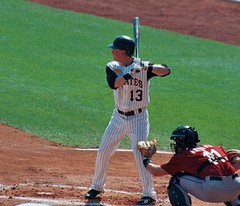Visits: 2
 After suffering through 16 consecutive losing seasons, many Pirate fans wonder how any team’s management could be more inept; how any team’s ownership could be more stingy. And who could blame them? The streak of sub-.500 finishes will soon be historic.
After suffering through 16 consecutive losing seasons, many Pirate fans wonder how any team’s management could be more inept; how any team’s ownership could be more stingy. And who could blame them? The streak of sub-.500 finishes will soon be historic.

- Image by Matt Bandi, MVN via Flickr
The sudden and unexpected trade of All-Star outfielder Nate McLouth on June 3 was viewed by many as a microcosm of the past decade and a half of losing. The Atlanta Braves acquired McLouth in exchange for starting pitchers Charlie Morton and Jeff Locke and outfielder Gorkys Hernandez. While many experts feel the Pirates will come out ahead long-term — What a haul for an overrated “Gold Glover,” tweeted Keith Law — fans believe the team has given up on its present, and rightfully so. Same old Pirates.
But there is reason for hope at PNC Park. Since taking over for Dave Littlefield in September of 2007, general manager Neal Huntington has reshaped the organization. In his first full season at the helm, Huntington spent a record amount on his June amateur draft class. He traded two of the club’s prolific veterans, Xavier Nady and Damaso Marte, to the New York Yankees for pitchers Daniel McCutchen, Ross Ohlendorf and Jeff Karstens and outfielder Jose Tabata. Then they traded a third veteran, Jason Bay, to the Boston Red Sox as part of a league-shaking three-way deadline deal.
There is reason to believe that the McLouth deal might work out for the best.
When he traded Nady and Marte to the Yankees, Huntington was smeared on message boards, blogs and talk radio. Nady was in the midst of a career year, hitting .330/.383/.535 as part of baseball’s most productive outfield, and Marte was a shutdown setup man in the bullpen. Tabata’s star had fallen since being ranked as the game’s 27th best prospect by Baseball America in 2007, and the pitchers seemed to be castoffs from a team rich in bonus babies with golden arms.
Nearly a year later public perception has turned. “The move was hailed as a steal for a Yankees club desperately trying to reach the postseason, [but] subsequent events have muddied the waters,” writes Moshe Mandel of The Yankee Universe. Nady hit just .268/.320/.474 down the stretch and Marte’s ERA ballooned to 5.40 as New York missed the playoffs in 2008, and neither player is contributing much in 2009.
Meanwhile, Ohlendorf has emerged as the Pirates’ No. 3 starter, posting five wins and a 4.45 ERA through 10 starts. Tabata and McCutchen were ranked as the third and ninth best prospects in the system by Baseball America entering 2009 and appear destined for big-league futures.
The Bay trade was even less popular. Arguably the team’s most impressive player, Bay was given away for nothing: The Pirates received outfielder Brandon Moss and reliever Craig Hansen from the Red Sox, and third baseman Andy LaRoche and starting pitcher Bryan Morris from the Los Angeles Dodgers, who had been shipped enigmatic superstar Manny Ramirez from Boston.
Moss and Hansen were viewed as role players on a contending team and nothing more (and perhaps that’s all they are). Morris’ stuff graded out well, but he had trouble staying healthy; Pirate fans know all about stud pitchers succumbing to Dr. Andrews’ scalpel. And another LaRoche? They knew all about those underachievers, too.
The situation got worse in August and September as the power-hitting Moss struck out at an alarming rate. LaRoche stumbled out of the gate and hit .152/.227/.232 over the remainder of the season, all the while making error after error at third base. What had Huntington done?
In his first full season with the Pirates at age 25, Bay hit .314/.377/.660 through 50 games. Eventually, he’d win the National League Rookie of the Year award, and in later seasons would be named to All-Star teams and receive MVP votes.
And in his first full season with the Pirates at age 25, LaRoche hit .297/.366/.424 through 50 games. His defense seems to be improving at a premium position. He is a team leader in on-base percentage, and his strong pedigree is showing. Pirate fans have little reason to doubt him as a cornerstone for the next winning club in Pittsburgh, even if his power is slow to come.
Just as Rome wasn’t built in a day, the destruction left behind by Littlefield won’t be cleaned up in a season or two. The Bay trade will be judged by the seasons of control exchanged; one and a half of the Canadian left fielder for 20 of the prospects. The McLouth trade will yield 18 seasons of Morton, Locke and Hernandez.
As the 2009 campaign progressed, Huntington realized that his team’s odds of making the playoffs were slim (Baseball Prospectus figured them at less than 10 percent). As always, he is building for next year, and for the year after that. Once again as the trade deadline approaches, he will seek to move veteran contracts in favor of minor leaguers with upside. Adam LaRoche, John Grabow, Jack Wilson and Freddy Sanchez could all be gone by August 1. To paraphrase Billy Beane, if you’re not going to win 90 games and reach the postseason, you might as well only win 70.
Combined with aggressive movement in international free agency — the Pirates have been linked to top Dominican prospect Miguel Angel Sano — and keen navigation of the Rule 4 draft, Huntington’s trades should lead to a top-ranked minor-league system and a sustainable winning culture in Pittsburgh.

![Reblog this post [with Zemanta]](http://img.zemanta.com/reblog_e.png?x-id=9bbfdac6-73ad-4c1e-a464-f7162a843878)


4 Comments
You must be logged in to post a comment Login